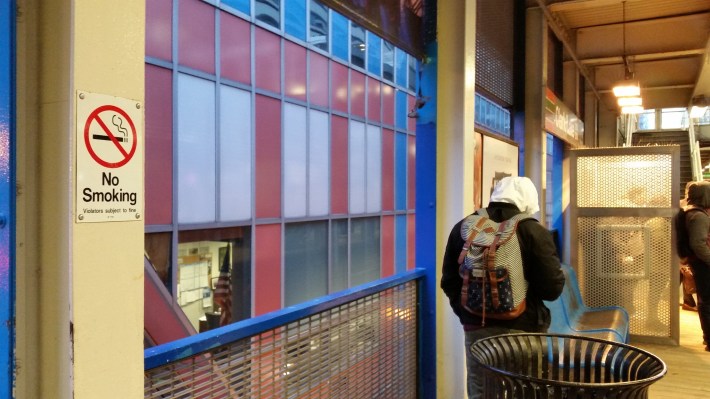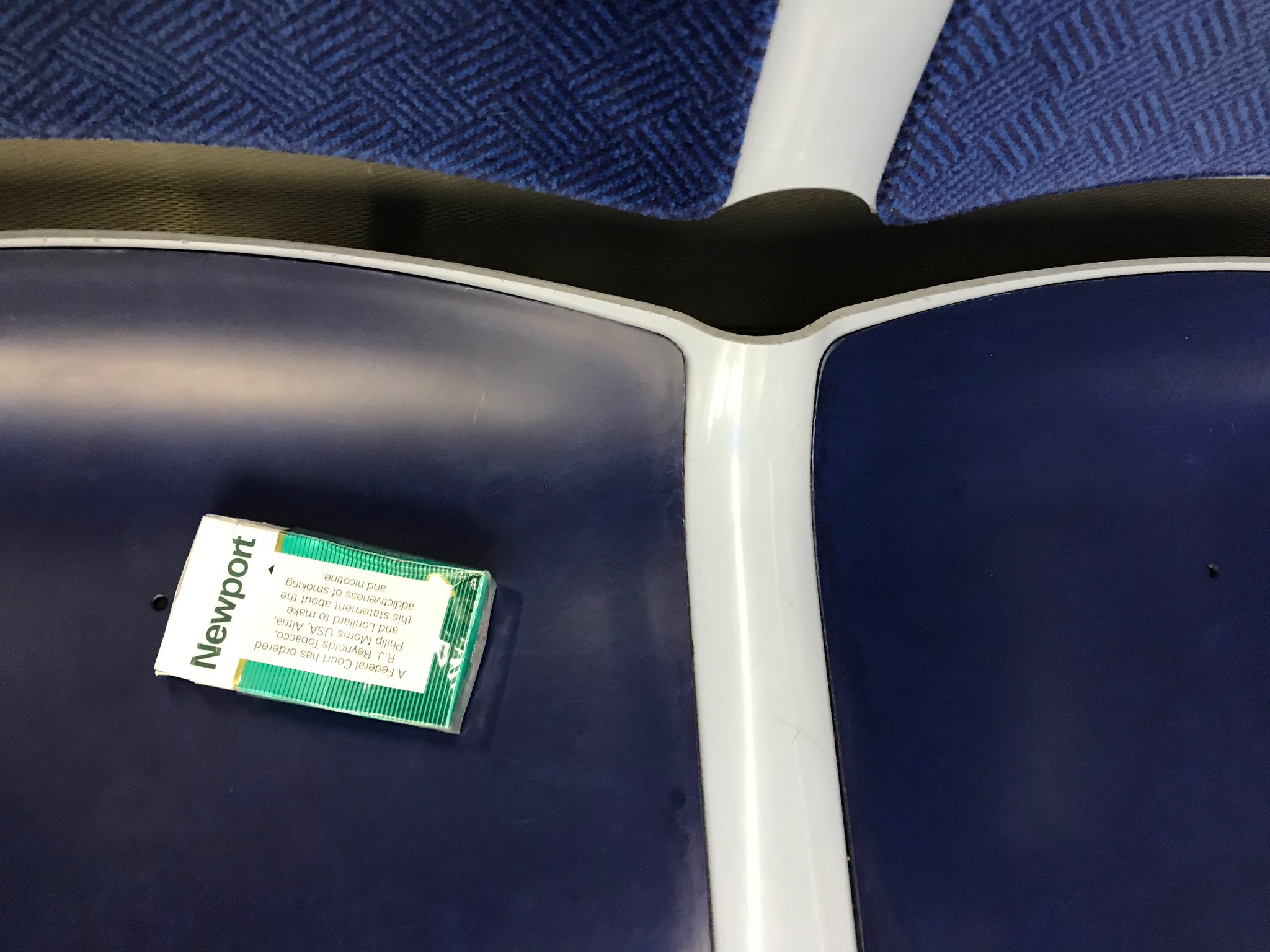[A version of this article ran in the Chicago Reader.]
I'll never forget the first time I walked into a hot-boxed CTA el car. On a weeknight two summers ago, I was heading home from the Grand Red Line station. As the train doors opened, I stepped into a haze of smoke and breathed in the telltale, love-it-or-hate-it aroma of marijuana. A group of teenagers passing a joint were nearly rolling in the aisle with laughter. Not being a weed aficionado myself, I rolled my eyes and headed to the next carriage.
Since then, it appears that the phenomenon of CTA customers illegally smoking pot or, more often, cigarettes on trains has picked up speed. Nowadays it seems like every other time I ride the 24-hour Red or Blue lines in the late evening, there's evidence that someone has recently smoked or toked on transit, or is about to. Judging by comments from Streetsblog readers and on social media, this issue seems to have shifted into high gear in recent months, especially during the brutal winter we just survived.
There's a correlation between the apparent increase in marijuana and cigarette smoking on trains and the decrease in CTA ridership due to the rising popularity of Uber and Lyft, especially on weekends. During the first 11 months of 2017, el boarding fell by 12 percent on Saturdays and 13 percent on Sundays, compared to that period in 2015. Fewer people riding trains may embolden smoking scofflaws to light up, since it lowers the chances of other passengers reporting them. The fine for smoking or vaping on CTA property, enforced by Chicago Police Department officers, ranges from $100 to $300.
Ticketing numbers provided by the police department in request to a Freedom of Information Act request indicate that smoking on transit, or at least the enforcement of it, is on the rise. There were 3,795 CPD-issued citations from smoking on CTA property in 2017, but 6,832 smoking tickets in 2018, an 80-percent increase.
A Streetsblog reader called my attention to the issue earlier this year, complaining that he's exposed to secondhand smoke once or twice a week on the train, and said the problem is especially prevalent on the Forest Park branch of the Blue Line. "It is clear to me that they . . . do not care about their fellow passengers or any possible repercussions."
In response to a Facebook query I posted, Danielle McKinnie, a technical trainer at a hospital, also told me CTA smoking is on the rise. After a recent PM commute on the Red Line, during which people were walking through the train smoking, her husband picked her up at 95th Street. "He asked where I had been because I smelled like smoke," she said. "He thought I'd been to a club."
Fans of the Twitter feed CTA Fails concur. "Literally, actually sick of all the smokers on the Blue Line," tweeted one. "Every day, there's a car full of smoke."
"Nothing like [coming from] the AM commute reeking of weed," tweeted another. "We will all surely be making great impressions today."
Not everyone has a problem with getting a CTA contact high. "I was stuck on the Blue Line once, with everyone freaking out and getting pissed," production designer Vanessa Mathai said in response to my Facebook post. "Some dude pulls out a huge joint and smokes up half the car while we waited. Just lovely!"
But assuming you're not cool with a lungful of someone else's dank weed or cancer-stick smoke, what's the best response? You could confront them, but that carries a certain amount of risk. Last month CBS noted that reported incidents of violent crime on CTA platforms increased from 263 cases in 2014 to 447 incidents in 2018. Already this year we've seen everything from a CTA worker being used as a human shield and repeatedly stabbed during a fight at the Roosevelt station, to a hammer attack on a Red Line car near Grand.
As an alternative to a direct confrontation with a smoker, a CTA spokesperson recommended switching cars at a stop and using the intercom to notify the train operator. Of course, that could delay the train and piss off fellow customers. The rep also noted that "No Smoking" signs are ubiquitous on CTA property, and the agency recently launched a PR campaign to remind customers that puffing on public transportation is verboten.
So why do people still do it? To gain some insight, I rode the Red Line at 11 PM on a Tuesday and interviewed a few smokers. After boarding a southbound train at Jackson, I saw men walking between cars, calling out, "Squares [loose cigarettes], packs." After switching cars a few times myself, I encountered a young man with braids who was rolling tobacco in a brown tobacco leaf. He agreed that smoking is becoming more prevalent on public transportation. "It's because there's homeless people. They don't want to leave [the system] to smoke and then have to pay again."

There are currently about 80,000 homeless people in our city, according to an estimate from the Chicago Coalition for the Homeless. Anecdotally, people taking shelter overnight on the Red and Blue lines, often with large parcels in tow, or sleeping horizontally across the bench seating, seem to be increasingly common.
Nicole Richardson, vice president of clinical operations for Thresholds, a social service agency that helps people with mental illness, blamed Chicago's continuing homelessness crisis on a shortage of affordable housing, exacerbated by factors like the reduction of the number of SROs due to gentrification. While she didn't draw a direct line between the closure of half of the city's mental health clinics under the Emanuel administration and the high incidence of mentally ill people living on the street, she said "a gap in social services across our entire system" is contributing to the problem.
Thresholds has six outreach workers who try to build trust with homeless folks on the Red and Blue lines, as well as in the Thompson Center, the Pedway, the Harold Washington Library, and Lower Wacker. They offer food, water, clothing, and fellowship in hopes of eventually connecting people in need with social services.
The CTA, in cooperation with the Chicago Department of Family and Support Services also does outreach on trains to identify passengers who are continuously riding the 'L' and/or may need help, the transit agency said in a statement. "Working in teams with trained experts from social service agencies, CTA and its partners make every effort to connect individuals with the medical attention or social service support they may need."
On the other hand, the CTA employs security guards with German Shepherds to enforce quality-of-life rules on the Red and Blue lines during early morning hours. "Four teams of four officers each visit each railcar to make sure people are not sleeping or taking up more than one seat," the agency stated.
The CTA also has scheduled supervisors overnight at the Forest Park, 95th and Howard terminals, while the CPD has officers assigned to 95th and O’Hare stations during the overnight hours. "Often times, these supervisors and officers also will board trains arriving at the stations to check for homeless and/or continuous riders and assist those in need," the CTA stated. The CTA rules of conduct prohibit remaining in the system for more than one continuous trip without exiting the paid area and re-entering by paying a second fare or riding on the system continuously in excess of two hours without exiting the system.
Asked about a possible link between homelessness and an increase in train smoking, Richardson pointed to studies that suggest nicotine is more addictive for people with schizophrenia. People with mental illness have also been found to smoke at two to four times the rate of the general population. "Like any other drug, nicotine is a coping mechanism," she said.
Richardson acknowledged that smoking on transit is problematic. "I'm not a smoker, so I do find it annoying when I have to walk by somebody who is."
The CTA needs to find a better solution to this vexing problem, which could further drag down ridership. Perhaps installing airplane-style smoke detectors?
But in the meantime, those of us who don't need to shelter on trains should keep some perspective. Smoky el cars and other homeless-related quality of life issues on the CTA reflect Chicago's larger problems. Last week the City Council approved TIF funding deals for the upscale Lincoln Yards and The 78 megadevelopments. Many, including the Reader's Ben Joravsky, have argued that means $2.4 billion in future property tax revenue, which otherwise might have been used to address Chicago's many social justice challenges—including homelessness—has gone up in smoke.




